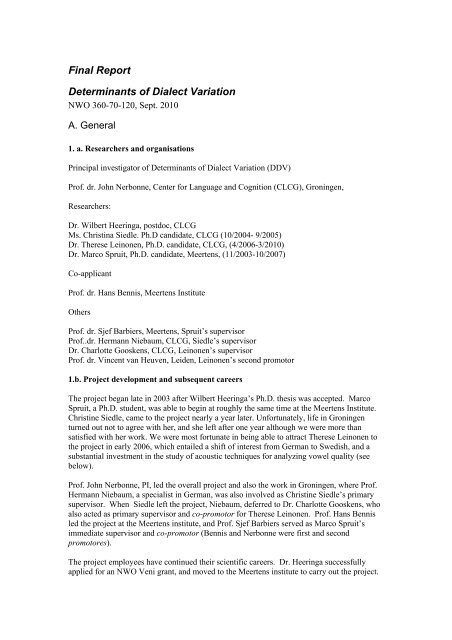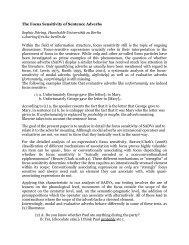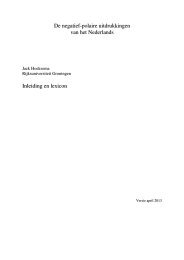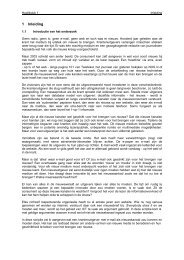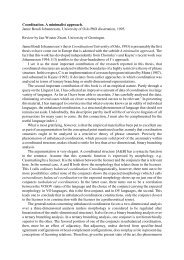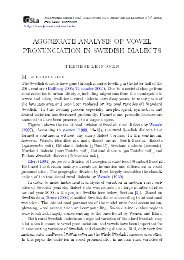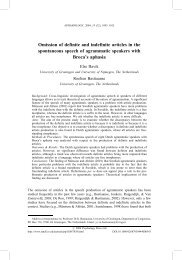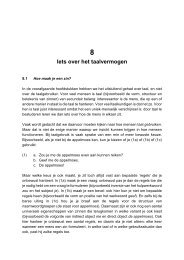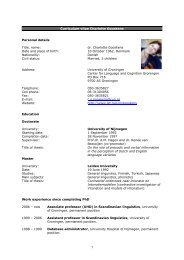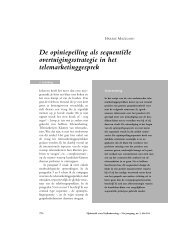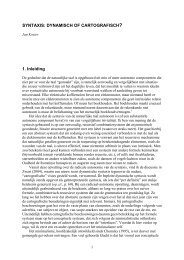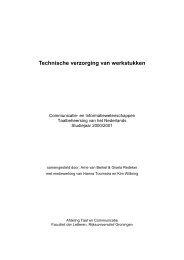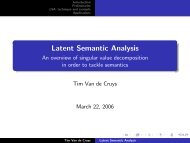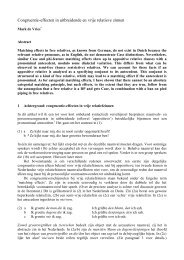Final Report Determinants of Dialect Variation
Final Report Determinants of Dialect Variation
Final Report Determinants of Dialect Variation
Create successful ePaper yourself
Turn your PDF publications into a flip-book with our unique Google optimized e-Paper software.
<strong>Final</strong> <strong>Report</strong><br />
<strong>Determinants</strong> <strong>of</strong> <strong>Dialect</strong> <strong>Variation</strong><br />
NWO 360-70-120, Sept. 2010<br />
A. General<br />
1. a. Researchers and organisations<br />
Principal investigator <strong>of</strong> <strong>Determinants</strong> <strong>of</strong> <strong>Dialect</strong> <strong>Variation</strong> (DDV)<br />
Pr<strong>of</strong>. dr. John Nerbonne, Center for Language and Cognition (CLCG), Groningen,<br />
Researchers:<br />
Dr. Wilbert Heeringa, postdoc, CLCG<br />
Ms. Christina Siedle. Ph.D candidate, CLCG (10/2004- 9/2005)<br />
Dr. Therese Leinonen, Ph.D. candidate, CLCG, (4/2006-3/2010)<br />
Dr. Marco Spruit, Ph.D. candidate, Meertens, (11/2003-10/2007)<br />
Co-applicant<br />
Pr<strong>of</strong>. dr. Hans Bennis, Meertens Institute<br />
Others<br />
Pr<strong>of</strong>. dr. Sjef Barbiers, Meertens, Spruit’s supervisor<br />
Pr<strong>of</strong>..dr. Hermann Niebaum, CLCG, Siedle’s supervisor<br />
Dr. Charlotte Gooskens, CLCG, Leinonen’s supervisor<br />
Pr<strong>of</strong>. dr. Vincent van Heuven, Leiden, Leinonen’s second promotor<br />
1.b. Project development and subsequent careers<br />
The project began late in 2003 after Wilbert Heeringa’s Ph.D. thesis was accepted. Marco<br />
Spruit, a Ph.D. student, was able to begin at roughly the same time at the Meertens Institute.<br />
Christine Siedle, came to the project nearly a year later. Unfortunately, life in Groningen<br />
turned out not to agree with her, and she left after one year although we were more than<br />
satisfied with her work. We were most fortunate in being able to attract Therese Leinonen to<br />
the project in early 2006, which entailed a shift <strong>of</strong> interest from German to Swedish, and a<br />
substantial investment in the study <strong>of</strong> acoustic techniques for analyzing vowel quality (see<br />
below).<br />
Pr<strong>of</strong>. John Nerbonne, PI, led the overall project and also the work in Groningen, where Pr<strong>of</strong>.<br />
Hermann Niebaum, a specialist in German, was also involved as Christine Siedle’s primary<br />
supervisor. When Siedle left the project, Niebaum, deferred to Dr. Charlotte Gooskens, who<br />
also acted as primary supervisor and co-promotor for Therese Leinonen. Pr<strong>of</strong>. Hans Bennis<br />
led the project at the Meertens institute, and Pr<strong>of</strong>. Sjef Barbiers served as Marco Spruit’s<br />
immediate supervisor and co-promotor (Bennis and Nerbonne were first and second<br />
promotores).<br />
The project employees have continued their scientific careers. Dr. Heeringa successfully<br />
applied for an NWO Veni grant, and moved to the Meertens institute to carry out the project.
Dr. Spruit accepted a lecturer position (universitaire docent) at Information Science, Utrecht.<br />
Therese Leinonen currently works as a postdoc on a CLARIN-NL project developing a web<br />
application for s<strong>of</strong>tware developed in DDV, and she’s accepted a position at the Svenska<br />
litteratursällskapet i Finland (Society <strong>of</strong> Swedish Literature in Finland, www.sls.fi) as a<br />
postdoctoral researcher. Ms. Siedle works for a digital cartography company in Düsseldorf.<br />
2. <strong>Final</strong> <strong>Report</strong> <strong>of</strong> Main Program<br />
a. Scientific Aims and Results<br />
The overarching research question <strong>of</strong> the project was formulated (see proposal, “Executive<br />
Summary”):<br />
What determines dialectal variation?<br />
The question was made more concrete by formulating three more specific objectives:<br />
1. quantification <strong>of</strong> the degree to which the linguistic levels pronunciation,<br />
lexis and syntax correlate<br />
2. development and application <strong>of</strong> a measurement for aggregate syntactic<br />
distance between varieties<br />
3. validation <strong>of</strong> phonetic distance measures within a new language, German<br />
The first objective was achieved by Wilbert Heeringa in a three studies, one <strong>of</strong> which was a<br />
collaborative effort with Marco Spruit and the principal investigator (Spruit et al. 2009). The<br />
surprising result is discussed in detail in the presentation <strong>of</strong> the postdoc project (below).<br />
We tackled the problem <strong>of</strong> measuring and assessing syntactic variation in exactly the way<br />
specified in the project proposal. The work was conducted on the Syntactische Atlas van de<br />
Nederlands <strong>Dialect</strong>en (SAND), and surprised one <strong>of</strong> the project members, who had publicly<br />
predicted that one would see little geographic structure in the data. See below for more<br />
details, including a “best young scholar award” prize awarded to Spruit in 2005.<br />
The third objective first involved German resulting in Nerbonne & Siedle (2005), in the<br />
leading journal for German dialectology, which further validated the pronunciation<br />
comparison. When Siedle left for personal reasons, we shifted focus to Swedish, whose<br />
dialectology was well-known to Therese Leinonen, Siedle’s replacement. This also led us to<br />
explore acoustics more than we’d expected, and to involve not only Dr. Charlotte Gooskens,<br />
Groningen, expert in Scandinavian languages, but also Pr<strong>of</strong>. Vincent van Heuven, Leiden,<br />
expert in phonetics.<br />
<strong>Determinants</strong><br />
We also devoted time to asking the overarching question <strong>of</strong> what influences dialect variation.<br />
The most influential earlier work on this was Trudgill’s 1974 paper introducing his famous<br />
“gravity model”, in which the influence <strong>of</strong> varieties is predicted to decrease quadratically (in<br />
distance) but to increase directly in proportion to population size. He buttressed this by<br />
tracing individual changes as they diffused. Our innovative step was to shift the view from<br />
individual features – such as the use <strong>of</strong> a new pronunciation – to the aggregate <strong>of</strong> differences.<br />
This, we argue, allows the research to examine the entire field <strong>of</strong> variation as a residue <strong>of</strong> the<br />
diffusion <strong>of</strong> all linguistic changes. The postdoc project (Sec.3) describes two published<br />
studies from this perspective (Nerbonne & Heeringa, 2007; Heeringa et al. 2007).<br />
Manni et al. (2008) involved a collaboration with population geneticists, in which we<br />
investigated whether there might be an influence <strong>of</strong> family on dialect variation. We show that<br />
genetically related groups indeed speak using similar linguistic varieties, but this is most<br />
likely due to the fact that they tend to settle nearby.
. Coherence <strong>of</strong> program<br />
The range <strong>of</strong> co-publications and publications in common venues (special issues <strong>of</strong> journals)<br />
suggests a good degree <strong>of</strong> collaboration, which in fact was even more extensive. Dr. Wilbert<br />
Heeringa deserves special mention for his role in instructing the PhD candidates and keeping<br />
the project on an even keel. We also acknowledge that we sacrificed opportunities for easier<br />
collaboration by organizing the project at two institutes, CLCG and Meertens. But while we<br />
missed some easy “on-the-shop-floor” exchanges <strong>of</strong> the sort one-site projects enjoy naturally,<br />
we remain unremittingly enthusiastic about the collaboration, which combines Groningen’s<br />
strengths in computational and quantitative methods with the Meerten’s strengths in<br />
overseeing the range <strong>of</strong> data and in syntactic theory.<br />
c. Added value <strong>of</strong> programmatic attack<br />
The opportunity to approach the questions programmatically allowed us to (i) increase the<br />
confidence in the new methods, esp. in the Ph.D. project on pronunciation, and in the firstever<br />
measurement <strong>of</strong> the influence <strong>of</strong> geography on syntax; even while we (ii) demonstrated<br />
that the quantitative approach enables dialectology to approach some deeper question <strong>of</strong><br />
causation in novel ways. <strong>Final</strong>ly, it was indispensable in (iii) allowing us to compare the<br />
influence <strong>of</strong> geography on different linguistic levels.<br />
d. Evaluation<br />
Both the program as a whole and also the postdoc project and the Ph.D. project exceeded the<br />
goals <strong>of</strong> the original proposal and were resounding successes. The Ph.D. project on<br />
pronunciation was also very successful, but in an unforeseen direction (acoustic phonetics).<br />
e. Publications “Synthesizing Results”<br />
Although the project originally envisioned a monograph as a synthesizing publication, the<br />
scientific climate has come to value articles as the more valuable contribution due to the<br />
refereeing they are normally subject to, and their greater focus. The three synthesizing articles<br />
were first, Nerbonne (2009a), “Data Driven <strong>Dialect</strong>ology” which makes the case for the<br />
viewing variation from an aggregate perspective. This is published in Language and<br />
Linguistics Compass, a new journal <strong>of</strong>fering primarily survey and programmatic articles.<br />
Spruit et al. (2009) synthesized work on lexical, pronunciational and syntactic variation, and<br />
appeared in Lingua. Nerbonne & Heeringa (2009) surveys techniques for measuring dialect<br />
differences, some <strong>of</strong> which emerged from the current project. It appears in a Mouton-De<br />
Gruyter handbook organized by Jürgen Erich Schmidt and Peter Auer.<br />
f. Incidental<br />
Naturally the day-to-day work led to incremental improvements in dialectometric technique<br />
as well which we note briefly here. Heeringa et al. (2006) surveyed the quality <strong>of</strong> string<br />
comparison algorithms. Wieling, Leinonen & Nerbonne (2007) initiated a new line <strong>of</strong><br />
research attempting to induce the pronunciation difference between individual segments (e.g.<br />
between [i] and [e]) from a large corpus <strong>of</strong> Dutch dialect pronunciations. Wieling, Heeringa &<br />
Nerbonne (2007) applied dialectometric analysis to the data collected by Goeman, Taeldeman<br />
& van Reenen in compiling the MAND and FAND collections. Nerbonne et al. (2008)<br />
examine the value <strong>of</strong> bootstrap clustering in dialectology, and also introduced noisy<br />
clustering, which gives roughly the same results (with low levels <strong>of</strong> noise) as the bootstrap.<br />
See 3.a.-b. for scientific fora and international involvement.
3. International Perspective.<br />
a. Contacts, etc. DDV was aggressive in seeking opportunities to present its work and subject<br />
it to the criticism <strong>of</strong> others. We began the project with a kick<strong>of</strong>f meeting in Groningen on<br />
Jan. 7, 2004, where Hans Goebl and Edgar Haimerl (Salzburg) and Georges de Schutter<br />
(Antwerp) were invited speakers. Goebl is the world’s authority on dialectometric technique,<br />
and De Schutter perhaps the leading expert in Dutch dialectology.<br />
Together with Bill Kretzschmar (Georgia, USA), a coordinator <strong>of</strong> American <strong>Dialect</strong> Atlas<br />
projects, we organized a special session at Methods in <strong>Dialect</strong>ology XII, Moncton, Canada,<br />
“Progress in <strong>Dialect</strong>ometry” in Aug. 2005 which about 50 researchers attended, and which<br />
resulted in a special issue <strong>of</strong> Literary and Linguistic Computing 21(4), 2006. The contributors<br />
included Heeringa, Spruit, Gooskens, Nerbonne, but also Goebl and Haimerl (Salzburg),<br />
William Kretzschmar, Cichocki (New Brunswick, Canada), Cynthia Clopper (The Ohio State<br />
University) and John Paolillo (Indiana, USA). We include a copy <strong>of</strong> this special issue with<br />
this report.<br />
Together with Franz Manni (Musée de l’Homme, Paris), editor <strong>of</strong> Human Biology, we<br />
organized a small session at Digital Humanities 2006, Paris. This resulted in a special issue<br />
<strong>of</strong> Lingua 119(11), featuring the Spruit et al. (2009) article, on the degree to which different<br />
linguistic levels correlate. See the subproject on syntactic variation (below) for more details.<br />
A copy <strong>of</strong> the special issue is enclosed with this report.<br />
Together with Erhard Hinrichs, Tübingen, we organized a more technically oriented satellite<br />
workshop at the joint COLING-ACL meeting in Sydney, July 23, 2006, Linguistic Distances.<br />
This workshop called for contributed papers on measuring linguistic distances, was<br />
deliberately broader in scope than dialectology, but it nonetheless attracted work on using<br />
string distances for identifying cognates (by Grzegorz Kondrak and Tarek Sherif, Alberta,<br />
Canada) and several proposals for measuring syntactic distance. There were 35 participants<br />
from Germany, Australia, Rumania, Ireland, the Czech Republic, India, Japan, the UK,<br />
Canada and Israel. We include a copy <strong>of</strong> the proceedings with this report.<br />
Together with Grzegorz Kondrak (Alberta, Canada) and T. Mark Ellison (Western Australia)<br />
we organized a satellite workshop on Computing and Historical Phonology on June 28, 2007<br />
at ACL 2007 in Prague. As we have only a single printed copy <strong>of</strong> this report, we refer<br />
interested readers to the online version at the ACL anthology, http://aclweb.org/anthologynew/W/W07/#1300,<br />
which we’ve mirrored at<br />
http://www.let.rug.nl/alfa/Prague/proceedings.pdf. Highlights were talks by Brett Kessler,<br />
Washington University, St. Louis, and Brian Joseph, The Ohio State University (then editor<br />
<strong>of</strong> Language). There were participants from the US and Canada, Germany, the UK and the<br />
Netherlands, India, France and Australia.<br />
Together with Hinrichs (again) and Petya Osenova (Bulgarian Academy <strong>of</strong> Science, S<strong>of</strong>ia) we<br />
organized a satellite workshop Computational Phonology at Recent Advances in Natural<br />
Language Processing 2007 on Sept. 26, 2007 in Borovetz, Bulgaria. This was also part <strong>of</strong><br />
what developed into a satellite project sponsored by the Volkswagen foundation (see below,<br />
part b), and was attended by about 20 researchers from Bulgaria, Canada, France, Germany,<br />
Greece, Hungary, Italy, and the Netherlands. A copy <strong>of</strong> the proceedings is enclosed with this<br />
report.<br />
Together with Sebastian Kürschner (Erlangen), Charlotte Gooskens and Renée van Bezooijen<br />
(both in Groningen) we organized a special two-day long track at Methods XIII on Aug.4-5,<br />
2008 in Leeds. The proceedings appeared as Computing and Language <strong>Variation</strong>, a double<br />
special issue <strong>of</strong> International Journal <strong>of</strong> Humanities and Arts Computing 2(1-2), 2008, with
contributions from project members Leinonen, Heeringa, Gooskens and Nerbonne and<br />
international participation from Germany, the United Kingdom, Belgium, Italy, Finland, and<br />
China. We include a copy <strong>of</strong> the special issue with this report.<br />
b. Foreign contributions to project.<br />
We were fortunate enough to be invited to participate in the Volkswagen Foundation’s Unity<br />
and Diversity in Europe program. The presence <strong>of</strong> the NWO project in Groningen may have<br />
enhanced our chances <strong>of</strong> obtaining this. The project was conducted in collaboration with the<br />
Seminar für Sprachwissenschaft, Eberhard Karls Univesität, Tübingen, and the Bulgarian<br />
Academy <strong>of</strong> Sciences, S<strong>of</strong>ia. Pr<strong>of</strong>. Erhard Hinrichs, Tübingen and Pr<strong>of</strong>. Vladimir Zhobov,<br />
S<strong>of</strong>ia, were the other site leaders. The Groningen participation in the project consisted <strong>of</strong> a<br />
Ph.D. project conducted by Jelena Prokić from Oct. 1, 2006 through Sept. 30, 2010. Her<br />
Ph.D. will be awarded on Nov. 29, 2010 for thesis Families and Resemblances, investigating<br />
dialectology not only from a synchronic point <strong>of</strong> view (the focus <strong>of</strong> DDV) but also from a<br />
diachronic, historical one. Prokić collaborated with Heeringa, Leinonen and Nerbonne<br />
extensively during her Ph.D. period. See http://www.sfs.uni-tuebingen.de/dialectometry/ for<br />
a project web site and http://www.let.rug.nl/~prokic/ for publications.<br />
There is also interest in dialectology on the part <strong>of</strong> population geneticists, which led to John<br />
Nerbonne’s visiting the Musée de l’Homme as guest researcher in 2006 and 2007, and which<br />
resulted in a studies which complement DDV work first by examining more exotic languages<br />
(see Alewijnse et al. 2007 and van der Ark et al 2007); second, by examining the degree to<br />
which linguistic and genetic signals <strong>of</strong> relatedness correlate (see Manni et al. 2008); and third,<br />
by comparing techniques (see Nerbonne et al 2008c).<br />
Subprojects<br />
B.1. Subproject on Syntactic <strong>Variation</strong> (Ph.D. project)<br />
B.1.1 Researcher: Dr. Marco Spruit, Meertens Institute.<br />
B.1.2 Intended publication: The aim <strong>of</strong> the subproject was to apply dialectometric<br />
techniques to syntactic variation for the first time, and this was accomplished in Spruit (2005,<br />
2006a) and in more detail in Spruit (2008). A second goal was to investigate the degree to<br />
which syntactic, pronunciational and lexical variation co-vary, the focus <strong>of</strong> Spruit et al.<br />
(2009). <strong>Final</strong>ly, it was also a goal to investigate techniques for detecting the degree to which<br />
syntactic variables are associated. The work on this topic is quite original, and a first version<br />
was published in Spruit (2007).<br />
Marco Spruit defended his dissertation (Spruit, 2008) at the University <strong>of</strong> Amsterdam on Mar.<br />
26, 2008. A copy was sent to NWO.<br />
B.1.4 <strong>Final</strong> <strong>Report</strong>. The subproject on syntactic variation was conducted at the Meertens<br />
Institute by Marco Spruit. The aim <strong>of</strong> the subproject was to apply dialectometric techniques<br />
to syntactic variation for the first time. When we first presented the project, one leading<br />
syntactician predicted that because syntactic variation is organized along typological lines, it<br />
would be conditioned by geography to a far lesser extent than pronunciation. This turned out<br />
to be wrong.<br />
This subproject investigated three quantitative perspectives on syntactic variation in Dutch<br />
dialects. The first perspective applied a simple measure <strong>of</strong> difference (essentially Hamming<br />
distance) to the syntactic properties noted in the Syntactische Atlas van de Nederlands<br />
<strong>Dialect</strong>en (SAND) and uses these to classify the Dutch dialect varieties syntactically (Spruit,
2006a/b). This classification is compared with—and highly resembles—the traditional,<br />
perceptual classification based on subjective judgements first developed by Weinen and Daan<br />
(Spruit, 2005).. Spruit showed thus that syntactic variation patterns are geographically<br />
coherent. He was awarded an award as “excellent young researcher” by the Association for<br />
Literary and Linguistic Computing at the 2005 Methods XII conference in Canada for the<br />
presentation <strong>of</strong> his paper (Spruit, 2006a).<br />
In collaboration with Heeringa and Nerbonne Spruit then quantified the degrees <strong>of</strong> association<br />
between pronunciational, lexical and syntactic differences (Spruit et al. 2009). The analysis<br />
reveals that the linguistic levels <strong>of</strong> pronunciation, lexis and syntax are genuinely albeit<br />
modestly associated. It also turned out – surprisingly – that syntactic and pronunciational<br />
differences only as strongly associated with each another as each is with lexical differences.<br />
We had expected that the well known volatility <strong>of</strong> the lexicon would lead to rather different<br />
patterns. We comment on this central line <strong>of</strong> research more fully in the summary <strong>of</strong> the<br />
postdoc project (below).<br />
<strong>Final</strong>ly, Spruit developed a technique for searching for associations among syntactic<br />
variables using a data mining technique based on geographical co-occurrences (Spruit 2007,<br />
2009). This approach contributes to the validation <strong>of</strong> existing typological hypotheses and<br />
facilitates the identification and exploration <strong>of</strong> relations among linguistics variables in<br />
general.<br />
As an additional activity flanking this subproject, Nerbonne co-organized a workshop (with<br />
population geneticist Dr. Franz Manni, Musée de l’Homme, Paris) on comparing syntactic<br />
databases at the 2006 Digital Humanities meeting in Paris. Proceedings appeared in 2009 as<br />
The Forests behind the Trees in a special issue <strong>of</strong> Lingua (Nerbonne & Manni, 2009). It<br />
included the article by Spruit et al. but also articles by Michael Dunn (Max Plank Institute,<br />
Nijmegen), by Bendikt Szmrecsányi and Bernd Kortmann (Freiburg), by Sjef Barbiers<br />
(Meertens), by Pino Longobardi (Trieste), and by Jan-Wouter Zwart (Groningen). Nerbonne<br />
(2009a) introduced the special issue.<br />
Spruit was awarded the Ph.D. in Amsterdam on March 26, 2008. A copy <strong>of</strong> the<br />
dissertation was sent then to NWO.<br />
B.2. Subproject on Pronunciation <strong>Variation</strong> (Ph.D. project)<br />
2.1 Researcher: Dr. Therese Leinonen, CLCG<br />
2.2 Publications were intended applying the techniques Nerbonne and Heeringa had<br />
developed for Dutch to German. Christine Siedle worked on this subproject for one year,<br />
analyzing data that we had obtain from the Deutscher Sprachatlas (Marburg). While this<br />
resulted in a good publication in the leading journal for German dialectology (Nerbonne and<br />
Siedle, 2005), Ms. Siedle never settled comfortably in Groningen and left the project after a<br />
very good first year. Leinonen (2010) applies inter alia the Groningen techniques to Swedish<br />
data, and realizes this objective, but she goes on to apply acoustic techniques to the same data<br />
(see below).<br />
Therese Leinonen was awarded the Ph.D. degree at the University <strong>of</strong> Groningen on July 1,<br />
2010. A copy <strong>of</strong> the dissertation is included with this report.<br />
2.4 <strong>Final</strong> <strong>Report</strong> The goal <strong>of</strong> the subproject on pronunciation variation was to replicate<br />
studies that had been conducted earlier by Nerbonne and Heeringa on Dutch on another<br />
language. As we note above, this was accomplished.
We attempted to make the best <strong>of</strong> the difficult situation <strong>of</strong> Ms. Siedle’s leaving the project by<br />
bringing Therese Leinonen to it, who very much wished to work on Swedish dialects (Ms.<br />
Leinonen had worked on Swedish dialects at Kotimaisten kielten tutkimuskeskus, The<br />
Research Institute for the Languages <strong>of</strong> Finland). We therefore contacted Pr<strong>of</strong>. Anders<br />
Eriksson, Göteborg, a phonetician who had worked on the most recent large collection <strong>of</strong><br />
Swedish dialect material, SweDia. The nature <strong>of</strong> the SweDia data was certainly challenging<br />
given the range <strong>of</strong> analytical techniques we had worked with in Groningen until then.<br />
The data from the SweDia dialect database were recorded at 98 rural sites in Sweden and the<br />
Swedish speaking parts <strong>of</strong> Finland around year 2000. At each site approximately twelve<br />
speakers were recorded: three older women, three older men, three younger women and three<br />
younger men. But unlike the pronunciation data we had analyzed earlier from the<br />
Netherlands, Germany and Norway, which consisted <strong>of</strong> phonetic transcriptions <strong>of</strong> entire<br />
words, the SweDia data consisted <strong>of</strong> acoustic recordings <strong>of</strong> vowels alone.<br />
The vowel quality <strong>of</strong> nineteen different vowels was analyzed acoustically by means <strong>of</strong><br />
principal component analysis (PCA) <strong>of</strong> Bark-filtered spectra. The two extracted principal<br />
components can be interpreted roughly in terms <strong>of</strong> vowel height and advancement. A<br />
correlation with formant measurements <strong>of</strong> a subset <strong>of</strong> the data showed high correlations.<br />
Separate PCAs <strong>of</strong> vowels produced by male and female speakers effectively reduced the<br />
variation in the acoustic measures related to anatomical/physiological differences between<br />
men and women.<br />
<strong>Dialect</strong>al variation was studied both in each vowel and on an aggregate level. Both methods<br />
contributed to the understanding <strong>of</strong> the dialectal variation and were shown to complement<br />
each other. The thesis includes maps that display the pronunciation <strong>of</strong> each vowel in the two<br />
age groups at each site. Co-occurring vowel features were identified by a factor analysis. The<br />
aggregate analysis showed that when it comes to vowel pronunciation the Swedish dialects<br />
form a linguistic continuum without abrupt dialect borders. Within the continuous distribution<br />
<strong>of</strong> vowel features, however, some more coherent dialect areas can be identified. These areas<br />
coincide to a large extent with classifications that have previously been proposed for Swedish<br />
dialects.<br />
The analyses indicate a large-scale leveling <strong>of</strong> Swedish dialects. The linguistic distances<br />
between sites based on vowel pronunciation are significantly shorter for younger speakers<br />
than for older speakers. In central Sweden the aggregate distance in vowel pronunciation<br />
between older and younger speakers is large. In some peripheral areas the linguistic change in<br />
apparent time is significantly smaller.<br />
The ongoing change in vowel pronunciation in central Sweden is connected to an ongoing<br />
chain shift in front mid-vowels. This language change is the result <strong>of</strong> dialect contact in<br />
combination with convergence to Standard Swedish. For Standard Swedish the vowel shift<br />
means that a phoneme system which has been very difficult to describe structurally is being<br />
simplified in the course <strong>of</strong> time, as the vowel inventory becomes both smaller and more<br />
symmetrical.<br />
Therese Leinonen was awarded the Ph.D. degree on July 1, 2010. A copy <strong>of</strong> the dissertation<br />
is included with this report.<br />
B.3. Postdoc project on the determinants <strong>of</strong> dialectal variation.<br />
This project focused on the determinants <strong>of</strong> linguistic differences (geography, population<br />
sizes) and the relationships among linguistic levels (pronunciation, lexis, syntax, prosody).
1) <strong>Determinants</strong> <strong>of</strong> linguistic distances<br />
The first study is based on a high density network <strong>of</strong> 52 settlements which all lie within the<br />
Lower Saxon dialect area <strong>of</strong> the northern Netherlands. Pronunciation distances among the<br />
dialects <strong>of</strong> these settlements are calculated with Levenshtein distance on the basis <strong>of</strong><br />
transcriptions, taken from the Reeks Nederlandse <strong>Dialect</strong>atlassen, 125 words pronunciations<br />
per dialect. Geographic distances between settlements are obtained on the basis <strong>of</strong> longitudelatitude<br />
coordinates and ‘as the crow flies’. Geography accounts for 59% <strong>of</strong> the variance in<br />
the aggregated pronunciation distances when using a linear regression model. The populations<br />
<strong>of</strong> the different settlements were taken from the Geschiedkundige atlas van Nederland; Het<br />
koninkrijk der Nederlanden 1815-1931 Ramaer (1931) and date from around 1815.<br />
Geography and populations sizes are put in one model according to Trudgill’s linguistic<br />
version <strong>of</strong> the gravity model (where the constant is omitted): the population size product <strong>of</strong><br />
two locations divided by the geographic distance between the two locations. The gravity<br />
model did not add explanatory power in comparison to geography only. The contribution <strong>of</strong><br />
the population product independently is moreover positive, contradicting the predictions <strong>of</strong><br />
the gravity model! (Nerbonne & Heeringa, 2007).<br />
A second study is based on 27 varieties in the Netherlands and Flanders. The data had been<br />
collected by Renée van Bezooijen in 2001, pronunciations <strong>of</strong> 100 nouns per variety. The<br />
findings were similar: geography correlated significantly with the pronunciation distances<br />
again and explains 33% <strong>of</strong> the variance, but population size information, although statistically<br />
significant, had only a minor effect. (Heeringa, Nerbonne, Van Bezooijen and & Spruit,<br />
2007).<br />
2) Relationships among linguistic levels<br />
In the period between 1999 and 2002 Jørn Almberg and Kristian Skarbø compiled a database<br />
which consists <strong>of</strong> recordings and phonetic transcriptions <strong>of</strong> translations <strong>of</strong> the fable ‘The<br />
North Wind and the Sun’ in about 50 Norwegian dialects. On the basis <strong>of</strong> 15 <strong>of</strong> these<br />
recordings, pronunciation distances, lexical distances and prosodic distances are measured<br />
among 15 recordings. The pronunciation level significantly correlates with the lexical level<br />
(r=0.49) and prosodic level (r=0.43), and the lexical level significantly correlates with the<br />
prosodic level (r=0.18). The three levels are correlated with perceptual distances, i.e.<br />
distances among dialects as perceived by the speakers themselves. The perceptual distances<br />
were obtained by an experiment carried out by Charlotte Gooskens in the spring <strong>of</strong> 2000. The<br />
three linguistic levels correlate significantly with the perceptual distances, but highest<br />
correlation was found for the pronunciation level. Within the pronunciation level a distinction<br />
was made between consonants and vowels on the one hand, and between substitutions and<br />
insertions/deletions on the other hand. When correlating the separate levels with perception<br />
and using multiple linear regression analyses it appears that especially consonant substitutions<br />
play a major role (Gooskens & Heeringa 2006).<br />
In a second study the levels <strong>of</strong> lexicon and pronunciation are considered, using as data 360<br />
Dutch sites from the Reeks Nederlandse <strong>Dialect</strong>atlassen, 125 words per dialect. Lexical<br />
distances were measured using Goebl's ‘gewichteter Identitätswert’ (GIW), a method in which<br />
the coincidence <strong>of</strong> rarely used words counts more heavily than those <strong>of</strong> more frequent ones.<br />
Pronunciation differences are measured using Levenshtein distance. The two levels correlate<br />
significantly (r=0.63, p
In a third study the pronunciation level, the lexical level and the syntactic level are<br />
compared to each other and to geography using data <strong>of</strong> 70 Dutch dialects. This<br />
research is based on two Dutch dialectal data sources: the Reeks Nederlandse<br />
<strong>Dialect</strong>atlassen (pronunciation and lexis) and the first volume <strong>of</strong> the Syntactische<br />
Atlas van de Nederlandse <strong>Dialect</strong>en (syntax). Lexical and syntactic levels were<br />
measured using GIW. The three levels correlate signficantly with each other.<br />
Pronunciation is marginally more strongly associated with syntax (42%) than with<br />
lexis (38%) and syntax is much more strongly associated with pronunciation (42%)<br />
than with lexis (25%). %). The three levels were correlated to geographic distances,<br />
which are measured in kilometers on the basis <strong>of</strong> longitude-latitude coordinates and<br />
‘as the crow flies’. For all levels significant correlations were found. Pronunciation<br />
and syntax are more strongly associated with geography (47% and 45%, respectively)<br />
than lexis is (33%). Next the levels are correlated to each other again, but the<br />
influence <strong>of</strong> geography is filtered away as a factor <strong>of</strong> influence underlying the<br />
associations among the linguistic levels under investigation. Some influence between<br />
pronunciation and syntax remains (12%), although the association between<br />
pronunciation and lexis is stronger (14%). There is virtually no association between<br />
syntax and lexis (3%). (Spruit, Heeringa & Nerbonne 2009).<br />
Publications<br />
Alewijnse, B. Nerbonne, J. van der Veen, L. & Manni, F. (2007) A Computational Analysis<br />
<strong>of</strong> Gabon Varieties In Petya Osenova et al. (ed.) Proceedings <strong>of</strong> the RANLP<br />
Workshop on Computational Phonology. Borovetz. 3-12.<br />
van der Ark, R. Mennecier, P. Nerbonne, J. & Manni, F. (2007) Preliminary Identification <strong>of</strong><br />
Language Groups and Loan Words in Central Asia In Petya Osenova et al. (ed.)<br />
Proceedings <strong>of</strong> the RANLP Workshop on Computational Phonology. Borovetz, 13-20.<br />
Gooskens, Ch. & Heeringa. W. (2006) The relative contribution <strong>of</strong> pronunciation, lexical and<br />
prosodic differences to the perceived distances between Norwegian dialects. In: J.<br />
Nerbonne & W. Kretzschmar, Jr. (eds.), Literary and Linguistic Computing, special<br />
issue, Progress in <strong>Dialect</strong>ometry: Toward Explanation, 21(4), Oxford University<br />
Press, Oxford , 477-492.<br />
Heeringa, W.J., Nerbonne, J., Bezooijen, R. van, & Spruit, M.R. (2007). Geografie en<br />
inwoneraantallen als verklarende factoren voor variatie in het Nederlandse<br />
dialectgebied. Tijdschrift voor Nederlandse taal- en letterkunde, 123(1), Uitgeverij<br />
Verloren, Hilversum, 70–82.<br />
Heeringa, W. & Nerbonne, J. (2006) De analyse van taalvariatie in het Nederlandse<br />
dialectgebied: methoden en resultaten op basis van lexicon en uitspraak. Nederlandse<br />
Taalkunde, 11(3), 218-257.<br />
Leinonen, Th. (2008). Factor Analysis <strong>of</strong> Vowel Pronunciation in Swedish <strong>Dialect</strong>s.<br />
International Journal <strong>of</strong> Humanities and Arts Computing 2(1-2), 189-204.<br />
Leinonen, Th. (2010). An Acoustic Analysis <strong>of</strong> Vowel Pronunciation in Swedish <strong>Dialect</strong>s. PhD<br />
thesis, University <strong>of</strong> Groningen. GRODIL 83.<br />
Leinonen, Th. (submitted). Aggregate Analysis <strong>of</strong> Vowel Pronunciation in Swedish <strong>Dialect</strong>s.<br />
Submitted to Oslo Studies in Language (OSLa) March, 2010.<br />
Manni, F., Heeringa, W., Toupance, B. & J. Nerbonne (2008) Do Surname Differences<br />
Mirror <strong>Dialect</strong> <strong>Variation</strong>? Human Biology 80(1), Feb. 41-64.<br />
Nerbonne, J. (2009a) Introduction to The Forests behind the Trees. Lingua 119 (11) Spec.<br />
issue The Forests behind the Trees ed. by John Nerbonne and Franz Manni. 1581-<br />
1588.<br />
Nerbonne, J. (2009b) Data-Driven <strong>Dialect</strong>ology. Language and Linguistics Compass 3(1),<br />
2009, 175-198. DOI: 10.1111/j.1749-818x2008.00114.x
Nerbonne, J., Gooskens, C. Kürschner, S. & van Bezooijen, R. (2008a) Language <strong>Variation</strong><br />
Studies and Computational Humanities. International Journal <strong>of</strong> Humanities and Arts<br />
Computing, Special Issue on Language <strong>Variation</strong> ed. by J. Nerbonne, C. Gooskens, S.<br />
Kürschner, and R. van Bezooijen.1-18. DOI: 10.13366/E1753854809000287<br />
Nerbonne, J. & Heeringa, W. (2007) Geographic Distributions <strong>of</strong> Linguistic <strong>Variation</strong> Reflect<br />
Dynamics <strong>of</strong> Differentiation. In: S. Featherston and W. Sternefeld (eds.), Roots:<br />
Linguistics in Search <strong>of</strong> its Evidential Base, Studies in Generative Grammar 96,<br />
Mouton De Gruyter, Berlin, 267-297.<br />
Nerbonne, J., & Heeringa, W. (2009) Measuring <strong>Dialect</strong> Differences In: J. E. Schmidt and P.<br />
Auer (eds.) Language and Space: Theories and Methods in series Handbooks <strong>of</strong><br />
Linguistics and Communication Science. Berlin: Mouton-De Gruyter, Ch. 31, 550-<br />
567<br />
Nerbonne, J., Heggarty, P., van Hout, R. & Robey, D. (2008b) Panel Discussion on<br />
Computing and the Humanities. International Journal <strong>of</strong> Humanities and Arts<br />
Computing, Special Issue on Language <strong>Variation</strong> ed. by J. Nerbonne, C. Gooskens, S.<br />
Kürschner, and R. van Bezooijen. 19-37. DOI: 10.13366/E1753854809000299<br />
Nerbonne, J. , Kleiweg, P., Heeringa, W. & Manni, F. (2008c) Projecting <strong>Dialect</strong> Differences<br />
to Geography: Bootstrap Clustering vs. Noisy Clustering. In: Ch. Preisach, L.<br />
Schmidt-Thieme, H. Burkhardt & R. Decker (eds.) Data Analysis, Machine Learning,<br />
and Applications. Proc. <strong>of</strong> the 31st Annual Meeting <strong>of</strong> the German Classification<br />
Society Berlin: Springer. 2008. 647-654. (Studies in Classification, Data Analysis,<br />
and Knowledge Organization)<br />
Nerbonne, J.& Manni, F.(eds.) (2009) The Forests behind the Trees. Special issue <strong>of</strong> Lingua<br />
119 (11) 1581-1706.<br />
Nerbonne, J., & Siedle, Ch. (2005) Dialektklassifikation auf der Grundlage Aggregierter<br />
Ausspracheunterschiede. Zeitschrift für Dialektologie und Linguistik 72(2), 129-147.<br />
Spruit, M.R. (2005). Classifying Dutch dialects using a syntactic measure. The perceptual<br />
Daan and Blok dialect map revisited. In: Doetjes, J., Weijer, J. van de (eds),<br />
Linguistics in the Netherlands, 2005, John Benjamins, Amsterdam, 179–190.<br />
Spruit, M.R. (2006a). Measuring syntactic variation in Dutch dialects. In J. Nerbonne & W.<br />
Kretzschmar, Jr. (eds.), Literary and Linguistic Computing, 21(4), spec. issue,<br />
Progress in <strong>Dialect</strong>ometry: Toward Explanation, 493–506.<br />
Spruit, M.R. (2006b). Tellen met Taal. Het meten van variatie in zinsbouw in Nederlandse<br />
dialecten. In: Gerritsen, D., Verburg, A. (eds), Respons: Mededelingen van het<br />
Meertens Instituut, 8, Meertens Instituut, Amsterdam, 12–16.<br />
Spruit, M.R. (2007). Discovery <strong>of</strong> association rules between syntactic variables. Data mining<br />
the Syntactic atlas <strong>of</strong> the Dutch dialects. In: Dirix, P., Schuurman, I., Vandeghinste,<br />
V., Eynde, F. van (eds), Computational Linguistics in the Netherlands 2006. Selected<br />
papers from the seventeenth CLIN meeting, LOT Occasional Series, Utrecht, 83–98.<br />
Spruit, M.R. (2008). Quantitative perspectives on syntactic variation in Dutch dialects. PhD<br />
thesis, University <strong>of</strong> Amsterdam, LOT Dissertation Series 174, LOT, Utrecht, 157 pp.<br />
Spruit, M.R. (2009). Towards linguistic knowledge discovery in language variation databases.<br />
Zeitschrift für Dialektologie und Linguistik – ZDL-Beiheft 138, Low Saxon <strong>Dialect</strong>s<br />
across borders, Stuttgart: Franz Steiner Verlag, 179-193.<br />
Spruit, M.R., Heeringa, W., & Nerbonne, J. (2009). Associations among linguistic levels.<br />
Lingua, 119 (11), The forests behind the trees, Elsevier, 1624-1642.<br />
Wieling, M., Heeringa, W., & Nerbonne, J., (2007) An Aggregate Analysis <strong>of</strong> Pronunciation<br />
in the Goeman-Taeldeman-van Reenen-Project Data. Taal en Tongval 59(1). 84-116.<br />
Wieling, M., Leinonen, Th. & Nerbonne, J.(2007). Inducing Sound Segment<br />
Differences Using Pair Hidden Markov Models. In J. Nerbonne, M. Ellison &<br />
G. Kondrak (eds.). Computing and Historical Phonology: 9th Meeting <strong>of</strong> ACL<br />
Special Interest Group, Computational Morphology and Phonology, ACL Workshop


